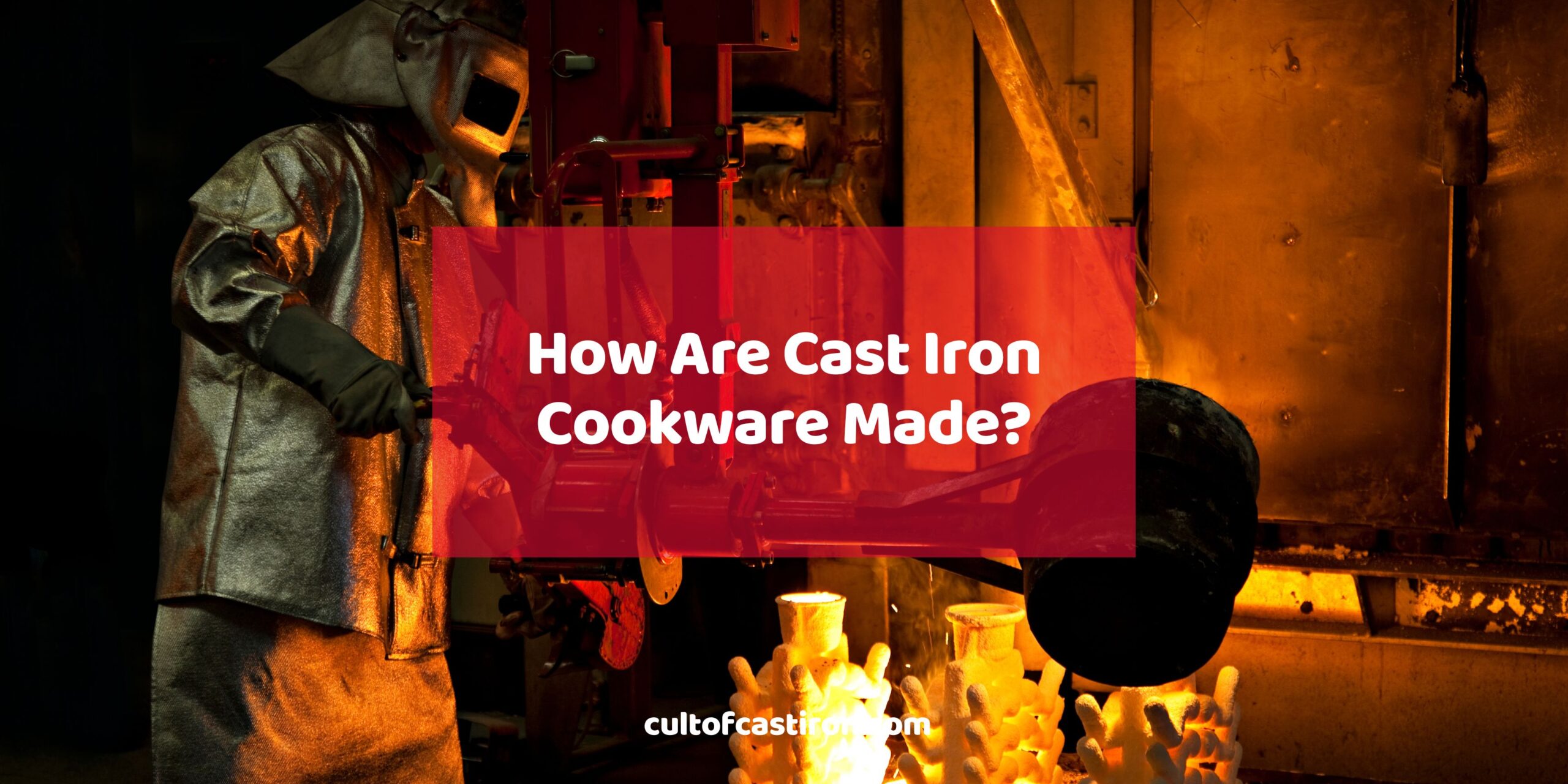I’ve been nerding out about cast iron cookware since 2021, and it has come to the inevitable point where I have to know how they are manufactured – mostly just for the heck of it.
If you’re in the same place as I am, then this article is for you!
What is Cast Iron?
Cast iron is a group of iron-carbon alloys that are characterized by their carbon content typically ranging from 2 to 4 percent. More importantly, cast iron gets its name from its manufacturing process called sand casting, wherein molten iron is poured over a sand mould until it solidifies into shape.
Now, there are four types of cast iron: gray, white, malleable, and ductile. Cast iron cookware is made of the relatively common and inexpensive gray cast iron variety. It is mostly made of iron (which should go without saying), along with carbon (2.5 – 4.2%), and silicon (1.0 – 3.0%) being the accepted range. It is further made up of trace amounts of manganese (0.5 – 1.0%), sulfur (0.02 – 0.25%), and phosphorous (0.02 – 1.0%).
This material is not called “gray” just for the heck of it. If you strip a cast iron pan of all of its layers of seasoning, you will see that the pan is gray-colored, not black. This coloration is due to the graphite formed by its carbon content. The graphite also makes the iron softer yet more durable than its white iron counterpart, which makes it more easily manipulated by machine tools.
Also read: Cast Iron Cookware 101: Everything You Need to Know
7 Steps of the Cast Iron Cookware Manufacturing Process
Pouring molten iron into a mold is just one step of the process. Here’s the rest of the cast iron cookware manufacturing process in order:
1. Pattern making
Pattern making is the process of creating the sand mold that the molten iron will be poured on.
Why sand? It’s because of the high melting point of cast iron (1204°C or 2200°F). Temperatures this high can easily destroy reusable moldings that are made of metal. Hence, sand castings are used for making cast iron cookware since sand has a higher melting point than iron (1700°C or 3090°F).
The pattern comes in two halves: one to form the actual shape of the product, while the other half forms the interior cavity. Since sand molds allow for much flexibility in design, cast iron can be easily fashioned into different shapes and sizes.
Also read: The 40 Different Types of Cast Iron Cookware and Their Uses – Explained!
2. Melting
Now, it’s time to melt the iron.
The main material used for melting is pig iron. It is obtained by smelting iron ore in a blast furnace, typically with coke and limestone. Pig iron contains high levels of carbon (between 3.5% to 4.5%) and other impurities. Scrap iron, is often added to the melting furnace to supplement the pig iron and help control the carbon content and improve the overall composition of the cast iron.
Also, alloying elements, such as silicon and manganese, may be added to the molten metal to achieve specific properties or modify the composition as needed. Once all of these are melted in the furnace, they are ready for the next step.
3. Casting
Casting is the process of pouring molten iron into a mold and waiting for it to solidify. As such, this is the most crucial part of the process.
Before casting, the mold cavity is prepared by assembling the two halves of the sand mold, which are created using patterns. Once the mold is prepared, the molten cast iron is poured into the mold cavity through a pouring basin or sprue. The molten metal fills the cavity and takes the shape of the cookware piece.
As the molten metal cools, it solidifies inside the mold to form the shape of the cookware piece. The solidification process may take several minutes depending on the size and thickness of the casting. Once the molten iron solidifies, the mold will be broken apart, and the sand will be collected and reused to create another mold for the next batch.
4. Machining
Once the cookware has been released from its molding, it will undergo the machining process to cut it to the desired shape, size, and weight by selectively removing materials from the product.
The most common imperfections that are removed from the cookware are the rough, excess metal bits that occur where the two halves of the sand casting meet. Moreover, imperfections in the molding may cause sharp metallic bits to protrude from the pan. These are ground down to ensure that the cookware is in its proper shape.
This step will also be where the machinist includes provisions for the nuts and bolts needed to fasten handles on the lids of Dutch ovens.
5. Finishing
The sand used for casting results in a gritty texture. That is why after achieving its desired shape, the quality of the cooking surface is further dialed in during the finishing process.
Three types of finishings cast iron cookware enthusiasts should be aware of. They are:
- Tumbled – the cookware is put through a rotating tumbler that contains metal grits that will remove rough bits and edges. This results in a gritty and rough texture.
- Ground – the cooking surfaces are polished and ground by hand until a relatively smooth surface is achieved.
- Milled – a more aggressive version of grinding, wherein a machine removes large chunks off the surface to make it completely flat and smooth. This process is extremely rare for cookware.
Note: Odd-shaped cookware, like corn sticks, muffin pans, and aebleskiver pans are usually not ground or milled due to their shape. Most likely, they are only put through a tumbling machine.
It is a hotly debated subject whether a pan with a smooth surface is more non-stick than those with rough surfaces Some companies, like Lodge, state that their products have rough surfaces by design to help oil adhere to the metal. They also added that the pan will become smoother over time as you build up the seasoning.
Also read: How to Polish Cast Iron: A Guide to Make Your Skillet Buttery Smooth
6. Seasoning
In the past, cast iron cookware came out of the factory unseasoned, and users had to season it at home on their own. This is not the case for modern cast iron pans. Most cast iron cookware in the market today comes pre-seasoned with at least one layer of seasoning as leaving them unseasoned for a time will make them susceptible to rusting during transport or when displayed in-store. This also makes them ready for cooking straight out of the box.
After the finishing process, the pans are applied with a thin layer of oil and inserted into a hot oven until it develops the black patina that we all know and love. The pans will now be ready for packing and shipping.
The seasoning varies depending on the brand. Some brands only do one layer, while others do three. The type of oil used for the seasoning also varies. I wouldn’t fuss about this much as you’ll be building a new layer of seasoning in time anyway, rendering the base pre-seasoning layer moot.
Also read: Cast Iron Seasoning 101: Everything You Need to Know
7. Enameling (Optional)
Enameled cast iron cookware skips the seasoning process altogether and goes directly to the application of the enamel coating.
After the finishing process, the bare cast iron implements are blasted with a base layer of enamel to protect them from rusting. From there, the implements are dried and heated in an oven to allow the enamel coating to harden.
The second coating of enamel is applied to the implements to completely seal off any pores that expose the bare cast iron inside. Usually, white or cream-colored enamel is applied on the inside, while the outside of the pan is colored with a more striking color. Again, the enameled cookware will undergo drying and heating in an oven to allow the second layer to set. After bolting on the handle, the product is now ready for packing and shipping.
Also read: Cast Iron vs. Enameled Cast Iron: Which One Should Home Cooks Get?
Casting Light on the Process
After the production process, it is now time for quality control officers to inspect the batch for deformities, and for the finished products to be packaged and shipped to their buyers. Chances are, one of these pieces are headed to your doorstep.
While each piece of cast iron cookware is extremely durable, you must not neglect your part in being a good custodian of the craftsmanship and heritage of cast iron cookware. If you want to learn more about that, then check out the rest of the Cult of Cast Iron Blog!

Miguel is a cast iron enthusiast from Cavite, Philippines. He works in the digital marketing field as a content marketing strategist. On the side, he manages a small online bookstore and tends to his plants.

